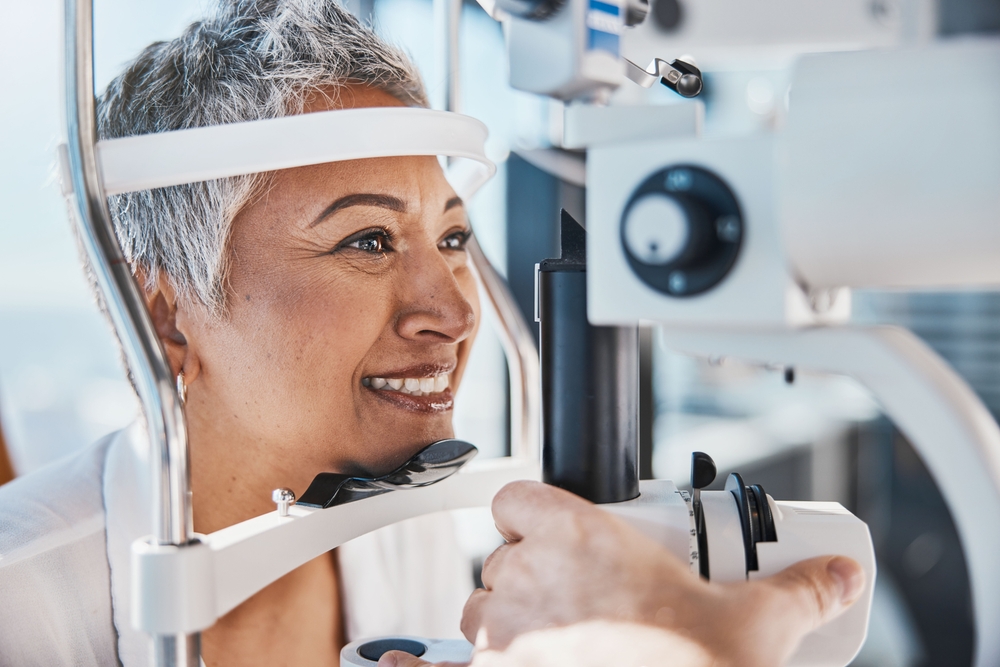If you’re experiencing vision changes that affect your daily activities, the Symfony® intraocular lens (IOL) might be the solution you’ve been searching for. This advanced extended depth of focus (EDOF) technology transforms patients’ lives by providing continuous, high-quality vision at multiple distances.
Understanding whether you’re a candidate for the Symfony lens involves recognizing specific symptoms and lifestyle factors that make this innovative IOL particularly beneficial. Let’s explore seven key signs that indicate you could be an excellent candidate for this cutting-edge vision correction technology.
What Makes the Symfony Lens Unique?

The Symfony intraocular lens is an FDA-approved extended depth of focus presbyopia-correcting intraocular lens. Unlike traditional monofocal lenses, which only correct vision at one distance, the Symfony lens extends the eye’s focus to deliver constant, high-quality vision across multiple distances, while correcting chromatic aberration for sharp, clear vision in all lighting conditions.
This revolutionary technology can be utilized in both cataract surgery and refractive lens exchange procedures, making it versatile for patients with a range of vision needs and eye conditions.
7 Signs You May Be a Symfony Lens Candidate
You may be a good candidate for cataract surgery or refractive lens exchange with the Symfony IOL if:
1. You Have Presbyopia

Presbyopia is a condition where the natural lens of the eye loses its flexibility. It typically begins affecting people in their early 40s, causing difficulty focusing on close objects.
If you find yourself holding reading materials at arm’s length or constantly reaching for reading glasses, refractive lens exchange (RLE) with the Symfony lens could restore your near vision capabilities. RLE is a vision correction procedure that involves removing the natural lens of the eye and replacing it with an IOL.
The Symfony lens, designed specially for patients with presbyopia, is often an excellent choice for RLE. Signs of presbyopia that indicate Symfony lens candidacy include:
- Struggling to read small print without glasses
- Eye strain and fatigue when doing close-up work
- Difficulty seeing clearly at intermediate distances, such as computer screens
- Dependence on multiple pairs of glasses for different activities
2. You Have Early Cataract Development
Cataracts are a common eye condition where proteins within the natural lens break down and form clumps as you age. If you’re experiencing the initial signs of cataracts, you may be an ideal candidate for refractive lens exchange with the Symfony lens.
These symptoms include:
- Faded or yellowed colors that lack their former vibrancy
- Increased sensitivity to bright lights and glare
- Difficulty driving at night due to halos around streetlights and headlights
- Needing brighter lighting for reading and close-up tasks
- Frequent changes to your prescription
- Blurred or double vision that glasses cannot fully correct
The Symfony lens addresses these cataract-related vision problems while providing the added benefit of presbyopia correction, eliminating the need for future cataract surgery.
3. You’re a Cataract Surgery Candidate
If your cataracts have progressed to the point where they are interfering with your ability to drive, work, read, or navigate your surroundings safely, it’s time to consider cataract surgery. Cataract surgery is performed almost exactly like RLE.
Your eye doctor will break up and remove your cataract-affected natural lens and replace it with an IOL. Cataract surgery with the Symfony lens can not only restore cataract-affected vision but also offer patients greater visual freedom after the procedure.
4. You Prioritize an Active Lifestyle

The Symfony lens particularly benefits patients who lead active lifestyles and want to reduce their dependence on glasses. If you participate in sports, travel frequently, or engage in hobbies that require clear vision at various distances, this lens technology can significantly enhance your quality of life.
Consider the Symfony lens if you:
- Want to reduce dependence on glasses for most daily activities
- Enjoy outdoor activities where glasses might be inconvenient
- Travel often and prefer not to manage multiple pairs of glasses
- Work in environments where switching between reading glasses and distance glasses is impractical
5. You’re 40 or Older
If you’re 40 years or older, you might be in the optimal age range for Symfony lens implantation through refractive lens exchange. Presbyopia and early cataracts often begin to impact patients around this age, so correcting your vision with refractive lens exchange, even before you start experiencing symptoms, can be a great way to be proactive about your vision and achieve independence from visual aids.
6. You Have Unique Refractive Errors
Certain refractive conditions make patients particularly good candidates for the Symfony lens:
- High degrees of nearsightedness that make LASIK less ideal
- Patients with thin corneas who aren’t suitable for laser vision correction
- Those with moderate astigmatism who can benefit from the toric version of the Symfony lens
- Individuals with extreme prescription needs that traditional glasses or contact lenses cannot adequately address
7. You Want Your Vision to Keep Up with Your Professional Demands
Your career requirements can indicate whether you’re a good Symfony lens candidate. Consider this technology if your work involves tasks that require clear intermediate and distance vision, such as working on a computer, driving, especially at night or in challenging lighting conditions, or presentations and meetings where you need to see clearly at various distances without constantly switching glasses.
When the Symfony Lens Might Not Be Ideal
While the Symfony lens benefits many patients, certain conditions might make alternative options more suitable:
- Severe astigmatism that requires specialized toric correction beyond what Symfony offers
- Unrealistic expectations about achieving perfect vision without any visual compromises
- Certain occupations requiring extremely precise near vision, such as fine jewelry work or detailed artistic endeavors
- Patients with existing eye diseases that could interfere with IOL performance
Making Your Decision

Determining your candidacy for the Symfony lens requires a comprehensive evaluation by an experienced eye surgeon. At South Texas Eye Institute, Dr. Lisa Martén utilizes advanced diagnostic technology, including ORA (Optiwave Refractive Analysis), to ensure precise measurements and optimal lens selection.
During your consultation, your eye doctor will assess your overall eye health, discuss your lifestyle needs, and help you understand how the Symfony lens can address your specific vision goals. Schedule your consultation at South Texas Eye Institute in San Antonio, TX, today!

